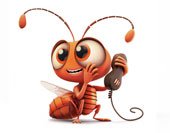
It is difficult to name a more famous “domestic” ant than the reaper. This is literally the most important ant, a frequent guest of the ant farm. Reapers are not common in most parts of the country, but it was with them that many began their passion for antkeeping. Let’s get to know them better and unravel the secret of their popularity!
Reapers are ants from the genus Messor. Most of them live in the steppes and deserts, where it is hot, dry, and there is little food. At midday, when the sun mercilessly roasts the earth, the ants hide in the deep cool galleries of the nest. In the summer, they come out only in the evening and wander in search of food until the morning. The usual food for Messors is dry seeds of cereals and other plants that collect on the surface of the soil. Having found a pile of grain that has fallen from the stem, the scout ant is in no hurry to collect it: having carefully examined the prey, weighed it in its mandibles and seemingly counted it, it returns home, touching the ground with the end of its abdomen along the way. Scouts create routes from guiding pheromones. Later, a group of collectors (foragers) moves along such a scent trail. These ants take the grains and carry them away, while the scouts make new paths to food sources. If there is a lot of food, then a whole living road connects it to the nest, along which workers scurry back and forth.
Harvester ants have a secret for making tasty and nutritious porridge. They take all the collected seeds to large round chambers underground – storage. There, the supplies lie dry, and specially assigned workers stir them, preventing them from spoiling. The main ingredients of ant porridge are grain and water. Where to get water in the desert? Resourceful six-legged engineers have thought of this too: they dig vertical shafts down to the aquifer, where moisture from precipitation accumulates. Some of the seeds are carried there and germinate. In the process, the seed softens, enriched with sugars. Later, such semi-finished products are taken up to the “kitchen” where soldiers work. What did soldiers forget there, where there is no need to fight? Soldiers are called individuals with a very large head, in which powerful muscles are located that control the jaws. Of course, they can protect the home, if necessary, but their main function is to grind seeds. Living mills chew the grains, turning them into a mush that feeds the rest of the adult ants and larvae. The processed grain contains water, carbohydrates, vegetable protein and fat – everything they need.
Despite the similar lifestyle, different species of Messor differ. Among them there are slow oafs, leisurely collecting seeds, there are also nimble ones, capable of catching up with insects, diversifying the diet with hunting. Coloring can also be different. The most common is the steppe reaper (Messor muticus). This is our domestic species, inhabiting the steppe zone. These ants are colored black or dark brown. A little further south lives the red-breasted reaper (Messor laboriosus / denticulatus), large workers can boast of a smart two-color coloring – a black head and abdomen, an orange chest. The red-headed reaper (Messor barbarus) is a guest from South-Western Europe. The large head of the barbarus soldiers is cherry or burgundy, and the body is glossy black. One of the largest Messors lives in Africa – it is the reddish-brown or black sand reaper (Messor arenarius), reaching a length of 1.8 cm. In addition to these species, there are many others, from which you can put together a good collection!
But before we move on to collecting, let’s look at care. Initial young families of a female and a couple dozen small workers are usually sold. They are kept in a test tube-incubator, where the necessary microclimate is maintained. Before moving to the farm, the family can exist there until the moment when the water in the test tube runs out.
Harvester ants feel good at room temperature, they do not need additional heating. They live well in farms of any design, except for wooden and gel ones. In general, they will develop if you follow simple recommendations: moisten the farm in time, add seeds as they are eaten and … And that’s it! You can leave them unattended for at least a week, nothing will happen to the inhabitants of the formicarium. Messors are the most unpretentious of all domestic ants, they can be recommended to beginners, even a child can cope with the maintenance. But if you need good development of the family, the rapid appearance of large individuals (soldiers), you cannot do without protein feeding: in addition to seeds, you should give food insects – cockroaches, crickets, mealworms. And the home anthill will prosper, delighting the owner for many years.





